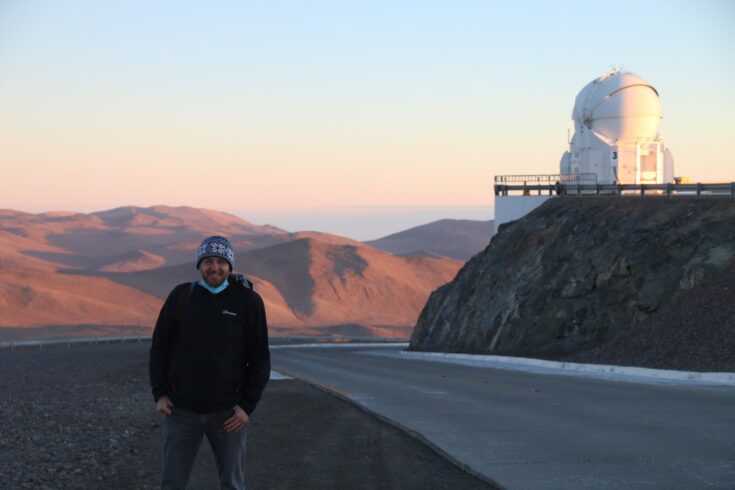The Atacama Desert in Chile is dry, high and remote. This is the exact opposite of what life requires. However, that’s what makes it the perfect place for astronomy. And is why the European Southern Observatory’s (ESO) Very Large Telescope (VLT) was very purposefully built in the middle of nowhere.
The stillness of the place is amazing. There’s no noise, no wind in the trees, animals or passing traffic. It makes you realise how used we have become to that background hum of life. It is a dead world where people shouldn’t really be; beautiful but utterly desolate.

The sun sets over the Very Large Telescope in Chile. Credit: William Taylor
Earlier this year I travelled from the UK Astronomy Technology Centre (UK ATC) in Edinburgh, via multiple flights and then by road into the mountains, to reach the VLT. I was there to carry out tests on the new instrument Enhanced Resolution Imager and Spectrograph (ERIS) as part of its commissioning programme.
State-of-the-art camera system
The ERIS instrument combines an imager (NIX) and an integral-field spectrograph (SPIFFIER), both of which use a laser-assisted adaptive optics system to enhance the imaging performance. Without adaptive optics the atmosphere dominates the quality of the image, no matter the size of your telescope. With adaptive optics image quality is instead limited only by the vast 8.2 metre mirror of the VLT, thus giving ERIS better image quality than even the Hubble Space Telescope.
The Science and Technology Facilities Council (STFC) provided funding to allow the UK ATC in Edinburgh to lead on the NIX imager, with key mechanisms provided by ETH-Zurich and high-contrast imaging components from Leiden.
Named after the Greek goddess of the night, NIX is a state-of-the-art, infrared, cryogenic camera system. Despite being only the size of a suitcase, NIX manages to pack a lot of functionality into a very small space. Allowing astronomers to capture those pin-sharp images with a range of filters and instrument set-ups, including some remarkable new high-contrast imaging optics that will deliver images of exoplanets.
First light
In February 2021 NIX was delivered to the Max Planck Institute for Extraterrestrial Physics (MPE) in Germany, who led the consortia of institutions and partners collaborating on ERIS, before it was delivered to Chile in December last year. It finally achieved first light a few months ago.

Scientific instrument ERIS installed on the Very Large Telescope Credit: William Taylor
First light is always an incredibly important milestone in any project. There were added challenges working on an international project like NIX through the COVID-19 pandemic, so this was my first opportunity to see NIX integrated with the rest of ERIS. It’s tremendously exciting to see an instrument you have worked on for so long in situ and working with the telescope.
I was at the VLT to check data and make sure the instrument was operating as anticipated. There’s a tick list of functional things: checking if it is letting in as much light in as expected; checking the image quality is good enough, checking the mechanisms all work, and more.
We were then able to start taking ‘typical’ observations, which involves choosing targets, planning the observing sequences, and then creating scripts to execute them. These scripts try to demonstrate how future astronomers will use the instrument and managed to throw up some unexpected quirks that we had to fix in real time!
High winds
Unfortunately, the one thing you can not control is the weather and we lost several nights due to the elements. When the temperature approaches zero they (wisely) worry about ice on the mirrors and we had to shut the domes. Likewise the wind caused multiple issues: degrading the image quality, restricting bits of the sky we could look at and even forcing us to head to bed early one night.
Having said that, it is amazing that even when it’s remarkably windy often the telescopes were still operational. It’s so strong you can hardly stand up straight but the secondary mirror in the telescope is taking out the wind shake in real time with the adaptive optics, so you can continue to point with amazing precision at something that’s light years away in the night sky. The VLT really is a remarkable bit of kit.
Shared goals
Beyond the unique natural environment what really struck me about the VLT is how the entire focus of the place is on keeping the telescopes running. There is nothing else around, so everyone has to work together. All those engineers and technicians making sure the telescopes are operating correctly so that at night astronomers can make observations. And also critically, all the support staff – from cooks to cleaners – making sure those engineers and technicians are maintained too, so that they can operate correctly in that remote world!
It’s all about one purpose, which is terribly inspiring.
The future of ERIS
ERIS has been offered to the community to start doing science in March next year. As a result of the time lost to bad weather, not all the observing modes are on offer yet, but after a final – extra – commissioning run is completed, the whole instrument will be ready to begin observing the Universe.
Top image: Credit: William Taylor



